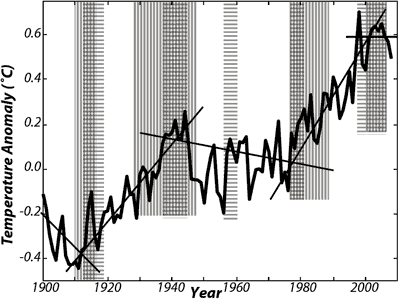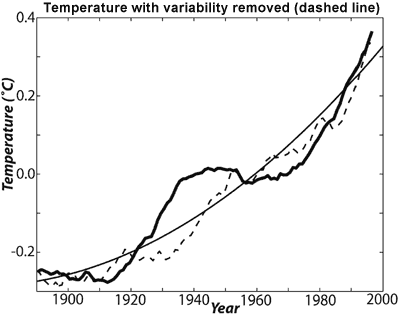Internal variability, climate shifts and human-caused global warming
What the science says...
A full reading of Tsonis and Swanson's research shows that internal variability from climate shifts merely cause temporary slow downs or speeding up of the long-term warming trend. When the internal variability is removed from the temperature record, what we find is nearly monotonic, accelerating warming throughout the 20th Century.
It's a climate regime shift
"For small changes in climate associated with tenths of a degree, there is no need for any external cause. The earth is never exactly in equilibrium. The motions of the massive oceans where heat is moved between deep layers and the surface provides variability on time scales from years to centuries. Recent work (Tsonis et al, 2007), suggests that this variability is enough to account for all climate change since the 19th Century." (Richard Lindzen)
The work of Tsonis and Swanson are often cited as evidence against man-made global warming. Their research suggests our climate is subject to dramatic regime shifts. At key moments, the climate shifts from a warm regime to a cool regime, or vica versa. They claim climate shifts occured around 1910, 1940, 1976 and 2001. Some have interpreted this work to say climate shifts can explain the last few decades of global warming. Richard Lindzen's take is that 'this variability is enough to account for all climate change since the 19th Century'. Is this what Tsonis and Swanson's research shows? The best people to answer this question are the authors themselves as they address this very question in their peer-reviewed work.
The initial paper by Tsonis, Swanson and Kravtsov proposed that climate is subject to a phenomenon called synchronised chaos (Tsonis et al 2007). When examining a number of ocean cycles such as the El Nino Southern Oscillation and North Atlantic Oscillation, it was observed that the various ocean cycles synchronised at certain moments after which climate seemed to shift to a new regime. In 1910, the synchronisation was followed by a warmer regime and several decades of warming. Another synchronisation occured in 1940, switching to a cooler regime. This coincided with mid-century cooling from 1940 to 1970. In the 1970s, the planet began warming again.

Figure 1: HadCRUT3 global mean temperature over the 20th century, with approximate breaks in temperature indicated. The cross-hatched areas indicated time periods when synchronization is accompanied by increasing coupling (Swanson & Tsonis 2009).
Conventional understanding for the switch to warming in the 1970s is that warming from CO2 overcame cooling from forcings such as sulfate aerosols. Tsonis and Swanson suggest an 'alternative hypothesis, namely that the climate shifted after the 1970s event to a different state of a warmer climate, which may be superimposed on an anthropogenic warming trend'. It's this final phrase, 'superimposed on an anthropogenic warming trend', that Swanson and Tsonis explore further in a subsequent research.
In 2009, they continue to examine the coupling of ocean cycles, stressing 'caution that the shifts described here are presumably superimposed upon a long term warming trend due to anthropogenic forcing' (Swanson & Tsonis 2009). They extend their analysis further in a paper that uses climate modelling to separate man-made and natural variability (Swanson et al 2009). When internal variability is filtered from the smoothed observed temperature (solid black line), the cleaned signal (dashed line) shows nearly monotonic warming throughout the 20th Century. In fact, the cleaned signal fits a quadratic shape which indicates the warming is accelerating.

Figure 2: Observed GISS 21-year running mean global mean surface temperature (heavy solid) along with that temperature cleaned of the internal signal (dashed). The cleaned global mean temperature warms monotonically, and closely resembles a quadratic fit to the observed 20th century global mean temperature (thin solid) (Swanson 2009).
If climate shifts do actually occur, Tsonis and Swanson's research finds they are not responsible for the warming found over the 20th Century. Instead, they superimpose variability over the long-term trend which is that of steadily accelerating warming. This is consistent with observations which find the planet has been accumulating heat since 1950 (Murphy 2009). Climate shifts do not stop the planet's energy imbalance. They merely cause temporary slow downs or speeding up of surface temperature warming.
Nevertheless, the theory of climate shifts has some unresolved issues. A key result of Tsonis and Swanson's work is that a shift to a cooler regime occured around 2001/2002. This shift is more marked in the HadCRUT record which is not a global temperature record. When Arctic regions are included, the global warming trend is greater in recent years and hence the 2001/2002 shift is not so pronounced. Hence the theory is dependent somewhat on an incomplete global record.
Another issue discussed in Swanson 2009 is that if climate is more sensitive to internal variability than currently thought, this would also mean climate is more sensitive to imposed forcings. This includes radiative forcings such as a warming sun, cooling from sulfate aerosols or warming from CO2. This leads to a crucial question that the authors themselves raise but don't answer. Conventional thought is that the warming sun and reduced volcanic activity caused much of the early 20th Century warming. Similarly, cooling from increased sulfate aerosols was a major contributor to mid-century cooling. In suggesting climate shifts as the cause, the authors offer no physical explanation as to why the warming sun and cooling aerosols didn't have their expected effect?
Nevertheless, if these issues are resolved and Tsonis and Swanson's theory is found to be valid, it's clear that climate shifts do not invalidate the human influence on climate. On the contrary, they show that underneath internal variability is a long-term trend. Tsonis and Swanson's analysis finds that imposed forcings have exerted a monotonic and accelerating warming trend throughout the 20th Century.
Intermediate rebuttal written by vrooomie
Update July 2015:
Here is a related lecture-video from Denial101x - Making Sense of Climate Science Denial
Last updated on 29 October 2016 by pattimer. View Archives































 Arguments
Arguments


































Climate Myth...